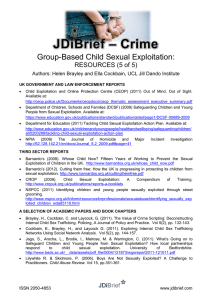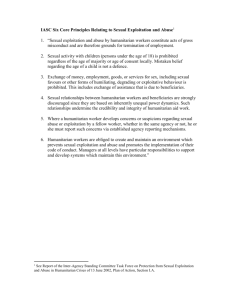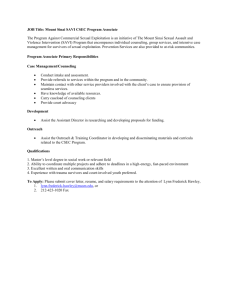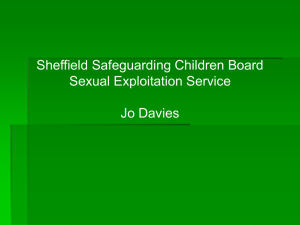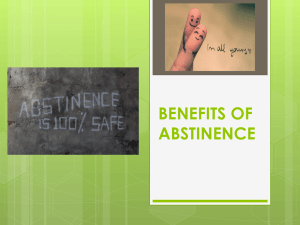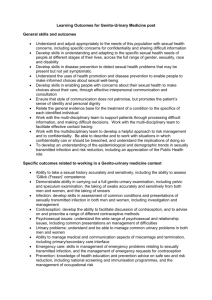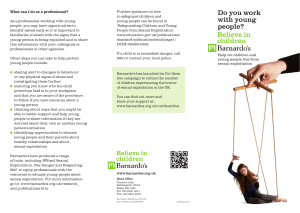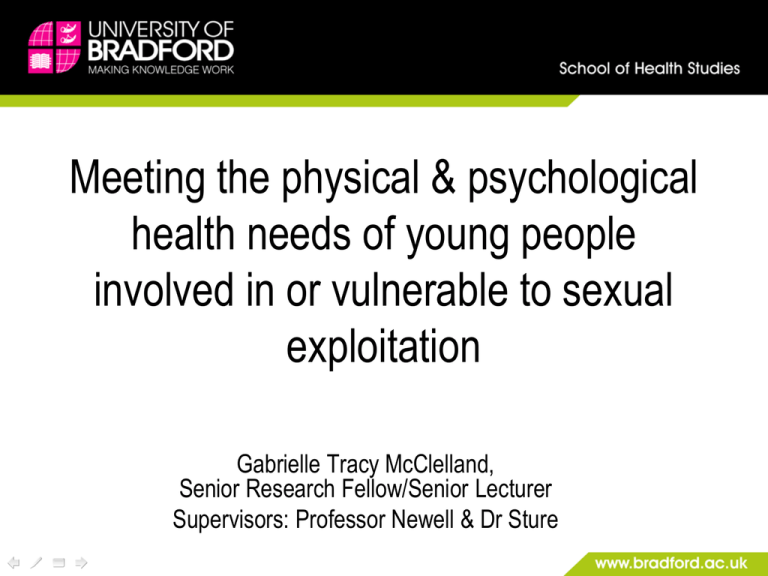
Meeting the physical & psychological
health needs of young people
involved in or vulnerable to sexual
exploitation
Gabrielle Tracy McClelland,
Senior Research Fellow/Senior Lecturer
Supervisors: Professor Newell & Dr Sture
Defining child sexual exploitation
Child sexual exploitation involves
exploitative situations, contexts &
relationships where young people receive
‘something’ as a result of performing &/or
others performing on them sexual
activities
Reference: National Working Group for Sexually Exploited Children & Young
People.
2
Language is important
As it influences the response towards young
people e.g. affair rather than exploitation
denies the criminal element
3
• There is always a power differential between a
vulnerable young person and an adult
• Autonomy is eroded in cse,
• Self determination and choice are reduced
• The young person may be objectified & seen as a
commodity
• Human rights are infringed
4
Background to the study
• Accurate prevalence data do not exist ;
(various estimates of scale & unreliable data)
• Child sexual exploitation is a contemporary global
issue effecting thousands of children.
• Recent high profile events have drawn attention to
child sexual exploitation (JC & HW).
• There has been a recognition that sexually
exploited children & young people are abused
children requiring safeguarding, not prosecuting.
5
Value of the research
• Emphasis is on prevention, protection & prosecution
(limited attention to cse prior to 2000, SCIP, updated 2009)
• Explores strategies to improve health & reduce risk
• Health is an ‘Every Child Matters’ outcome
6
Value of the research
• Raises profile of vulnerable young people
• Offers young people a chance to express their opinions
about matters that effect them (silent consumers of health care)
• This is novel & original research in an under researched
area (research available tends to relate to familial sexual abuse,
over 18’s & sex work)
7
Research aims
• To identify the range of physical & psychological health
needs of sexually exploited young people.
• To explore perspectives of risks to health.
• To identify barriers to meeting health needs.
• To recommend strategies to improve health.
8
Methodology
Study Design
Sequential mixed methods
Phase 1- Phenomenological approach taken. Face to
face interviews were undertaken with 24 young people
involved in or vulnerable to sexual exploitation.
Phase 2- A questionnaire survey was undertaken in 11
agencies with professionals supporting this group.
9
The young people
• Were aged between 13 & 18 years
• Two young people were male & 22 were female
• One young person described herself as Black
British
• One young person described herself as Pakistani
• Twenty two young people were White British
10
Health issues included
•
•
•
•
Physical health
Psychological health & intentional self harm
Sexual health
Drug & alcohol misuse
11
Physical health
•
•
•
•
•
•
Under weight: 5 (3 describe self as anorexic)
Over weight: 2
Poor sleep: 3
Deep vein thrombosis:1
Hepatitis C+:1, Hepatitis B +:1
Physical assaults
12
Psychological health
•
•
•
•
•
•
Stress: 4
Anxiety: 2 (1 fears going out)
Panic attacks: 2
Emotional problems: 5
Low mood: 8.
Paranoid thoughts: 2
13
Intentional self harm
• 5 people reported self laceration.
• 1 person burn her arm.
• 1 person swallowed razor blades
• 3 people reported self poisoning
• 1 person sniffed gas (with suicidal intent)
14
Sexual health
Most young people reported using genito-urinary medicine clinics
•
•
•
•
•
Sexually assaulted:3
Slept with men for shelter:1
Unplanned pregnancy:7
Miscarriage: 2
Planned termination of pregnancy: 1.
15
Reported drug use
Current drug use:18, no drug use 5, not discussed 1
amphetamine (8) ecstasy (9) cocaine(3) crack (3)
heroin (4), (2 intravenous drug users & described self
as a ‘prostitute’)
cannabis: 12, tobacco: 14
16
Reported alcohol use
Declared alcohol use:16
Not stated alcohol use but use drugs:5
No drug use & no alcohol use:3
Drinking patterns
Safe limits:1
Increased & high risk drinking: 8
Dependent use:7
17
Important factors in accessing health care
according to young people & professionals
in this study
Staff
Service design
Service delivery
18
Staff
• Staff who are able to display warmth,
empathy & respect
• Have a genuine interest in them & other
young people
• Young people prefer to be supported by
people whom they consider to be young.
• Prefer choice of gender of staff
19
Service design (what it offers)
• Local, accessible, open access
• Short time to be seen/receive test results
• Young people prefer services that combine
interventions
• Support for their families & significant others
involved in their lives.
• Help lines targeting young people to offer health
advice & information
• Age specific services
• Health support & health education in schools
20
Service delivery (How the service is provided)
• Age appropriate information
• Avoid treating young people as adults or patronizing
them.
• Consultation with young people regarding service
design/delivery.
• Respect, confidentiality & autonomy to make choices
• Option to be escorted to appointments by a familiar
person
• Combining a difficult intervention with a positive
experience
21
Recommendations
•
Child & young person oriented services
•
Flexible services central to the young person’s
needs
•
Open access & outreach services
•
‘Front of house’ staff who are skilled & friendly
•
Clear & accessible confidentiality policies
22
Recommendations
•
Early identification & intervention
•
Interagency, multi-professional working
•
Care & protection delivered together
•
Harm reduction approach
•
Holistic care
23
In summary……..
• Significant levels of health problems were reported by
both the young people in this study & the professionals
supporting them.
• A taxonomy of risk taking behaviours was apparent
• Frequent examples of health needs being inadequately
addressed were cited.
• Vulnerability is increased by not addressing health needs
24
effectively
Thank you
Gabrielle Tracy McClelland
25


